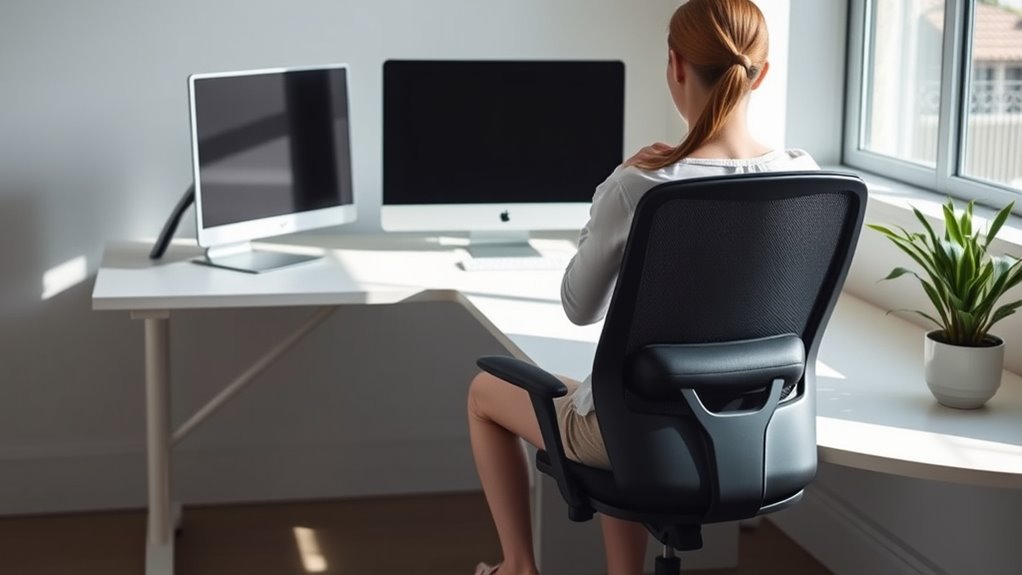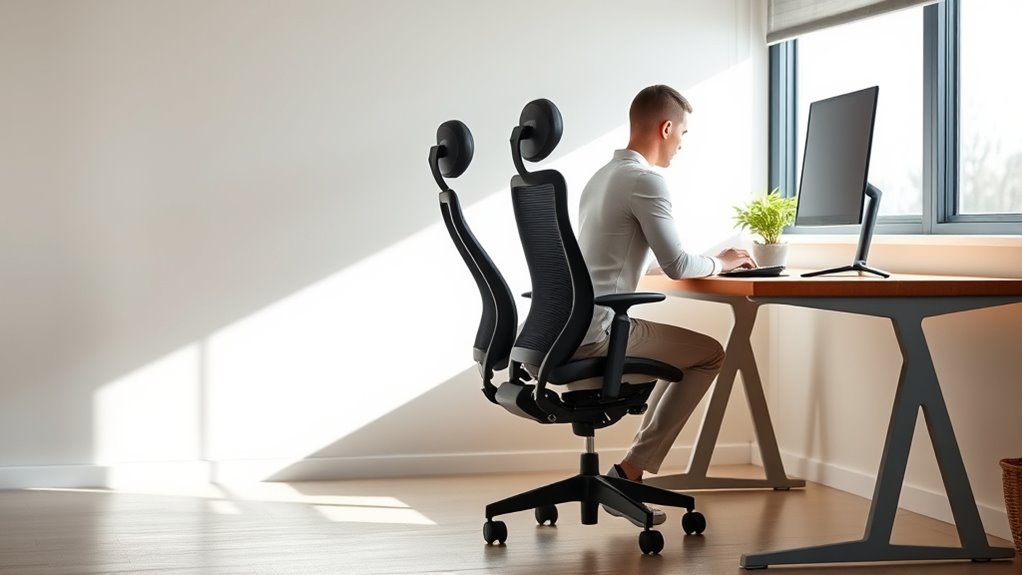To silence back pain, set up your desk with ergonomic essentials like an adjustable chair, monitor at eye level, and a footrest to keep your knees at a 90-degree angle. Incorporate lumbar support cushions and guarantee your keyboard and mouse are within easy reach. Remember to take regular breaks and stretch to improve circulation and reduce tension. By optimizing your workspace, you’ll support good posture daily—keep going to discover even more strategies to boost your comfort and confidence.
Key Takeaways
- Use an adjustable chair with lumbar support for proper spinal alignment.
- Position your monitor at eye level to prevent neck strain.
- Keep feet flat on the floor or on a footrest to support lower back health.
- Incorporate sit-stand desks to promote movement and reduce prolonged sitting.
- Take regular breaks and perform stretching routines to relieve muscle tension and reinforce good posture.

Have you ever wondered how your posture can influence your confidence and overall well-being? It’s not just about looking good; it impacts how you feel physically and mentally throughout the day. Sitting at a desk for hours can easily lead to poor posture, resulting in back pain and fatigue. That’s where ergonomic accessories come into play. Investing in items like an adjustable chair, a sit-stand desk, or lumbar support cushions can make a significant difference. These tools help align your spine properly, reducing strain and encouraging a healthier sitting position. However, simply having the right accessories isn’t enough. Incorporating stretching routines into your daily schedule can further enhance your posture and prevent discomfort. Gentle stretches for your neck, shoulders, and back loosen tight muscles and promote circulation, helping you maintain a more upright and relaxed stance.
Good posture boosts confidence and well-being through ergonomic tools and daily stretching routines.
When setting up your workspace, focus on creating an environment that encourages good posture. Your monitor should be at eye level, so you’re not tilting your head forward or backward. Keep your feet flat on the floor or on a footrest, and ensure your knees are at a 90-degree angle. Your keyboard and mouse should be close enough that you don’t have to reach forward, which can strain your shoulders and upper back. Using ergonomic accessories like an adjustable monitor stand or a wrist support can further reduce strain. These small adjustments make it easier to sit correctly for longer periods, diminishing the risk of chronic back pain.
But, even with a perfect setup, staying sedentary for too long isn’t healthy. Break your sitting routine by taking short breaks every 30 minutes. During these breaks, do stretching routines that target commonly tight areas, like your chest, hips, and hamstrings. For example, a simple chest stretch against the wall can open up your shoulders, counteracting the hunched posture that often develops from desk work. Similarly, hip flexor stretches can relieve tightness from sitting too long, helping maintain proper pelvic alignment. These movements boost blood flow, reduce muscle tension, and remind your body of the importance of good posture.
Ultimately, posture power comes from a combination of ergonomic accessories and consistent stretching routines. By paying attention to your workspace setup and making time for movement, you reinforce healthy habits that can silence back pain and elevate your confidence. When your body feels supported and aligned, your posture naturally improves, which radiates outward in your demeanor and overall health. Small, intentional adjustments each day can lead to lasting benefits, transforming your desk time from a strain into a source of strength.
Frequently Asked Questions
How Often Should I Take Breaks During Desk Work?
You should take a break every 30 to 60 minutes during desk work. During these breaks, incorporate stretching routines to relieve muscle tension and improve circulation. Using ergonomic accessories like adjustable chairs and monitor stands can also reduce strain. Stand up, stretch, and move around regularly to keep your back healthy. This habit helps prevent discomfort and promotes better posture, making your workday more comfortable and productive.
What Are the Signs of Poor Posture?
You might notice poor posture through signs like neck strain, shoulder tension, or back pain after long periods of desk work. Your body may feel stiff, and you could develop headaches or numbness in your limbs. To avoid these issues, use ergonomic accessories and focus on posture correction. Being mindful of your positioning makes certain you maintain good alignment, reducing discomfort and preventing long-term problems.
Can Ergonomic Chairs Prevent Back Pain Entirely?
An ergonomic chair offers many benefits, but it can’t prevent back pain entirely. You’ll find better back pain prevention when you combine its features, like lumbar support and adjustable height, with good posture habits. These chairs help maintain proper spine alignment, yet your awareness of your posture and regular breaks are vital. So, while ergonomic chairs substantially reduce discomfort, they work best when paired with mindful sitting practices.
How Do I Adjust My Monitor for Optimal Posture?
Imagine your eyes meeting your monitor’s screen, perfectly aligned. To achieve this, set your monitor height so the top of the screen is at eye level, avoiding strain. Keep the screen about an arm’s length away, reducing neck and eye fatigue. Adjust until your neck stays relaxed and your view feels natural. This simple tweak transforms your workspace, preventing discomfort and keeping you focused all day long.
Are There Specific Exercises to Strengthen My Back Muscles?
To strengthen your back muscles, focus on core strengthening exercises like planks and bridges, which support your spine. Incorporate regular stretching routines to improve flexibility and prevent stiffness. Consistency is key; aim to do these exercises several times a week. Remember, a stronger core reduces back pain and enhances posture, making your desk setup more comfortable. Always listen to your body and consult a professional if you’re unsure about proper form.
Conclusion
By optimizing your desk setup, you harness the power of good posture to prevent back pain. While some claim that perfect ergonomics can eliminate discomfort entirely, research suggests it substantially reduces strain and promotes long-term health. Remember, maintaining awareness and making small adjustments throughout the day truly makes a difference. So, take control of your workspace—your back will thank you for it, and you’ll feel more energized and productive every day.









